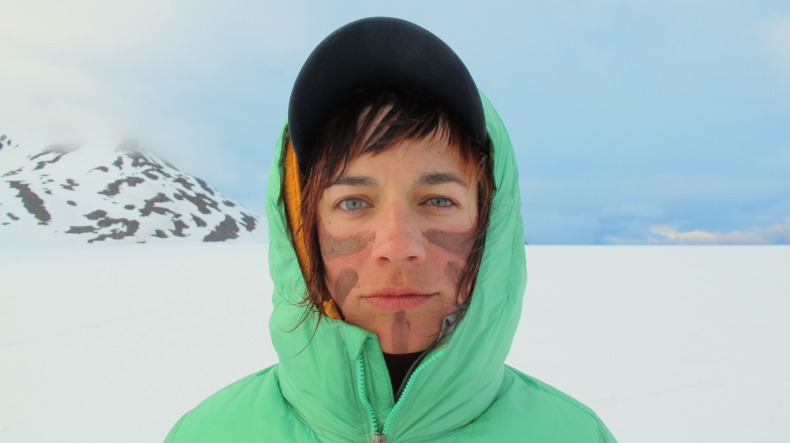LWON is celebrating the holidays by re-running some of our favorite posts. This post originally appeared in slightly different form in July 2014.
Sarah dipped her fingers in a red mineral paint and lifted them to her face. She put streaks above her cheekbones and up her chin, her design standing out against a backdrop of ice and barren, snowbound mountains. We were on the surface of the Harding Icefield, one of the largest remaining ice masses in North America. Five of us had skied a camp out onto the 700-square-mile face of this icefield and were now going primal.
She held out her palm full of pigment and painted brown-red stride-marks across my wind-dried face. Then she turned to our buddy Q, a filmmaker who was following us out here, and painted his face as well.
The pigment she used, coloring across our cheeks and down the bridges of our noses, was powdered red ochre mixed in the palm of her hand with water. It was something I always carried around in my pack, and every few years there’d be a day so perfect, so beautiful, I’d break it out. We’d just climbed a series of nunataks, mountain summits sticking up through the ice, and as a celebration, I got out the ochre.
Ochre is a general term for hematite, iron oxide. It is a ceremonial stone connected to ritual behavior at Upper Paleolithic sites around the world. Its use goes back to Neanderthal times, traced back to at least 250,000 years ago. It was a popular hit in the Americas once this side of the world got started. People wet and pulverized it, painting weapons with it, leaving traces on stone tools, burying the dead drenched in its brilliant red plumes, painting cave walls and the dry rock of canyons around the world. A Russian archaeologist who pulled up a 36,000-year-old grave in Siberia found the pit drenched in red ochre, what he described “as bright as fire and as scarlet as blood.”
Anything that ochre touches takes on a deep red gloss that bonds with other materials, making it the primary pigment for paint in the prehistoric world. When added to water, it takes on not only the color, but even the magnetic properties of blood. The first human art every made was found on nine carved red ochre pieces in South Africa, dating back 77,000 years. Perhaps for them it was like writing in blood, one of the powerful things a person could do.
I got this particular ochre from inside the Grand Canyon, used a knife to wheedle it out of a narrow, brilliant band in the Bright Angel Shale. My stash used to be as large as a fist, but now it has been shaved down to a bundle of powder this size of a thumb.
Ernst Wreschner, a palaeoanthropologist at the University of Haifa, wrote, “Prehistory has produced evidence for two meaningful regularities in human evolution: tool making and the collection and use of ochre.” It is one of the few resources we have used across almost all early cultures and periods. In the beginning, it may have served utilitarian purposes. Added to pine-mastic, it improves adhesives for hafting stone tools to handles. It also has preservative properties on skins and hides, and it is known to heal wounds, sores and burns. These qualities may have been why red ochre was used to preserve or ‘tan’ animal hides. It can maintain the skin of corpses, and has been found in burials worldwide, skeletons sometimes so awash in it they appear radiant. One archaeologist suggests that it could “represent a continuation of efforts to save the person’s life.”
Archaeologists often argue over what is utilitarian and what is ceremonial. If Sarah, Q and I were observed painting ourselves on the ice, might archaeologists consider this a ritual, and might they be right? It is, after all, one of the necessities of our species. Technology and symbolic behavior are the trademarks of human evolution, and all the way along, we brought ochre, the most common theme in ancient ceremonial sites, along with us.
When I collected this stash and began carrying it in my pack, I was not aware of its archaeological context. I only saw it as a slick and attractive pigment that could easily be applied to skin. I was subject to perhaps same attraction as the first people who used it, rubbing it between my fingers and watching my skin turn red. The name hematite comes from the Greek hema, blood. It looks like the blood of the planet.
When Sarah was done with Q’s face, she painted the whole of her palm and planted her handprint in the snow leaving a blush-colored track.
The first known painted hands, placed on a cave wall in Indonesia 70,000 years ago, used red ochre, as if the stone itself invited the act. Perhaps these oldest prints were meant to say the same thing Sarah was conveying as she pressed her reddened palm into the snow, a statement unique to the human race. In this theater of nunataks and ice-bound passages, it said, made of blood, we were here.
Photos by Craig Childs and Sarah Gilman

One thought on “Holiday Redux: The Ceremonial Stone”
Comments are closed.